From Gotcha to Understanding: Next-Generation Teacher Evaluations
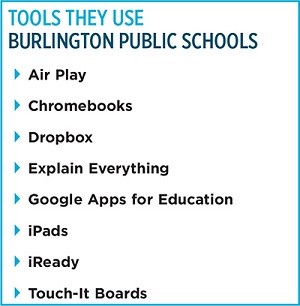
Nothing evokes as much fear in a teacher’s mind as the thought of his or her principal or other administrator popping in on a random Tuesday morning and saying, “Hi! I’m here to observe you.” Much like we wouldn’t want colleges to accept students based solely on their SAT scores, teachers don’t want to be evaluated solely on one 15-minute observation.
“Unannounced teacher observations remind me of ‘Ready or not, here I come!’ from the childhood game Hide & Seek,” says Patrick Larkin, assistant superintendent for learning at Burlington (MA) Public Schools (BPS). He knows that perpetuating a culture of distrust won’t improve teaching and learning, so instead, he and other like-minded district leaders are building collaborative environments that provide multiple opportunities for teachers and administrators to share and discuss best practices. Here’s a look at three districts that are using technology to turn teacher evaluations into a more positive experience.
BPS made a video to show teachers how to upload evidence in their shared folders.
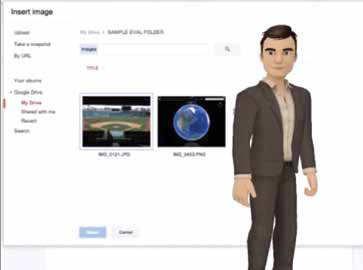
Google Drive Makes It Easy to Share Evidence
“If you want to change the culture, you need more than a checklist,” says Larkin. His district used to evaluate tenured teachers every other year and non-tenured teachers multiple times every year until they became tenured. But as a Race to the Top district, BPS now evaluates every teacher annually, with state-mandated unannounced observations on the docket. In the past, evaluators would work from a checklist, but Larkin has re-focused the format so the teams have conversations about best practices, good teaching, and learning. By using a state-generated list of items on which to evaluate teachers, the district chose the eight elements they thought were most significant and shared them with teachers.
Next, BPS created Google Drive folders for each administrator to share with the teachers he or she evaluates. Each teacher’s file contains 10 folders. Eight folders are designated for each of the evaluation elements, and two folders contain two teacher-created goals (one folder is for a student learning goal and one folder is for a professional practice goal). Teachers-- who all have iPads—must upload two or three pieces of evidence for each folder, such as videos, lesson plans, blog posts, photos, or examples of student work. “Teachers share evidence and the evaluators throw in stuff too, such as examples they’ve seen of great collaboration. When it’s time to sit down for a summative or formative assessment, the meetings are much richer and more productive. No more pulling stuff from three-ring binders on the fly. Now the work is being done continually,” says Larkin.
To help teachers get used to gathering evidence, which is new for many of these teachers, the district had an after-school PD session in which teachers met in grade- and subject-level teams to talk about what they were using to support their work. “We’re creating an evidence gallery for the entire district. I’m working with the head of the teachers’ union to compile evidence and artifacts from the eight elements to create a public model for all staff to see. We aren’t always clear on what would be good evidence so we’re sharing that,” Larkin shares.
Tools and ideas to transform education. Sign up below.
Talent Ed Perform Streamlines the Process
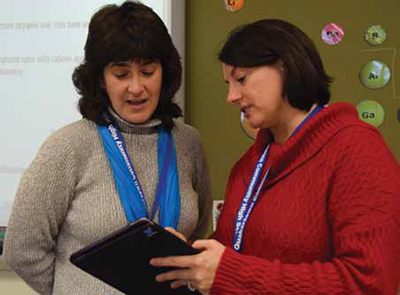
At Quakertown Community School District (QCSD) in [Add city] Pennsylvania, Superintendent Lisa Andrejko is cognizant of the difference between supervision and evaluation. “Supervision is the collaborative process in which you change behavior. Evaluation comes at the end,” she says. “In our district, teacher evaluation is based on improvement and collaborative dialogue.” In fact, the district’s model is based on a state rubric, self-evaluation, teacher reflection, goal setting, and artifacts to paint a robust picture of teacher supervision.

QCSD uses Netchemia’s Talent Ed Perform, and Andrejko says the program has enhanced the evaluation process tenfold because it’s easy to use, encourages dialogue, saves time, and saves records. Best of all, she says, the program is flexible and customizable. “It’s so intuitive that I was able to create forms by myself.”
Andrejko know that if a person doesn’t want to change their behavior, nothing will make them do it. That’s why she places a lot of emphasis on self-reflection and self-evaluation. Her teachers use the Talent Ed Perform rubric—made up of criteria, parameters, and state and district goals—to determine where they are. The principal for each teacher sees the comments, agrees or disagrees with the assessment, and then they set up a meeting to discuss the evidence. All of this happens via technology. “They rate themselves, upload evidence, and both [parties] analyze and develop an improvement plan, highlighting areas where help is needed. The end result is the evaluation.”
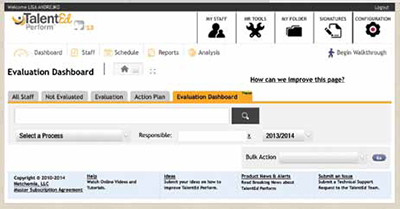
Top: QCSD teacher Darlene Hardy reviews her electronic portfolio with Assistant Principal Karen Shanton. TalentEd Perform streamlines the evaluation process for teachers and administrators.
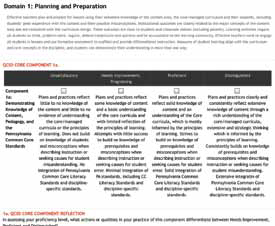
Although Andrejko loves how the technology improves the workflow, she knows the human connection is essential. “You have to be able to pick up the phone, meet in person, or use Skype. The technology is just a framework that starts the conversation. The real work is in the collaboration that results in better teaching and learning.”
In the past, a principal would observe a teacher once or twice and give a thumbs up or thumbs down. Now the principal collects multiple sources of data, including student achievement scores, teacher portfolios, and the self-evaluation. “The evaluation is not something your supervisor does to you; you have to own it,” she says. “I think most of our teachers like the back and forth [evaluation process] and [having their] principal act more like a coach.”
Teachers Improve Their Skills Using VIEWPath Video Cameras
Because Newton County (GA) School System had already installed VIEWPath (Video Interactive Education Window) Educam 360 audio and video equipment in all of its classrooms, teachers and administrators were able to get on board when the state rolled out a new evaluation process this year. “The last thing a teacher would want, I imagine, is some ‘Big Brother’ monitoring a camera and arbitrarily taking footage to use for evaluation. We don’t do that. We leverage the VIEWPath system only if a teacher authorizes an administrator to evaluate the video,” says Samantha Fuhrey, superintendent. “We’re all trying to examine what great teaching looks like, what teachers think it looks like, and [how to] learn from each other.”
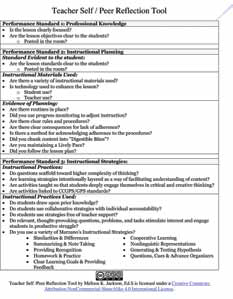
In last year’s VIEWPath pilot program, the district added Insight Education Group’s coaching component in which contracted coaches watched video footage. Rather than simply receiving advice on classroom management, teachers now receive content-specific coaching from instructors who viewed their videos. “The quality of the coaching feedback was transformational,” says Fuhrey. “I can give feedback on general teaching skills, but I’m not a history teacher, so I couldn’t help our history teachers get better at the content.” When one U.S. history teacher’s students looked bored during one of her lectures, the history coach provided video footage of 15 resources to help her do a deeper dive into the material.
Currently, the schools are at various stages of comfort in using videos for evaluation. Most of them are at stage one, in which teachers are required to record themselves at least once a week and review their own footage for strengths and areas of improvement.
Top right: Newton County teachers use a VIEWPath Reflection Tool for self-evaluation. Below, a group of teachers in a professional learning community collaborate on using SA FARI Montage.
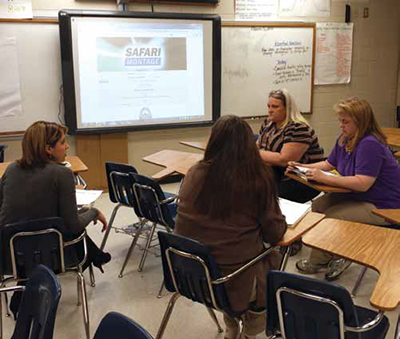
The second stage is where a teacher collaborates with a colleague of his or her choosing and they review each other’s videos. At stage three, all grade-level or content-area teachers record themselves, put their names in a hat, meet with their PLC, and draw names to see whose video will be screened. They act as internal coaches for each other.
“At the stage three schools, teachers are asking administrators and others to view their videos and offer feedback. [And I think] that that is wonderful,” says Fuhrey. “We want to pull this into a formalized evaluation where it’s second nature for teachers to have us view their video for evaluation. I think the quality of feedback will be revolutionized by the video cameras. You can pause, rewind, and make sure you’re hearing everything accurately. The cameras are so high quality you can even see how the students are reacting.”
Teacher Observation Tools
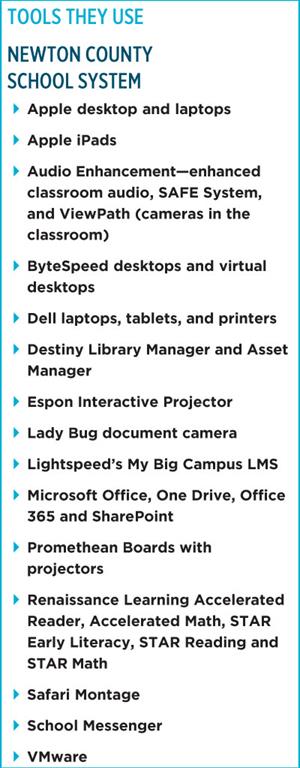
BloomBoard
www.bloomboard.com/schools
Google Drive
drive.google.com
Halogen TalentSpace
www.halogensoftware.com
Insight Education Group’s Teacher Effectiveness Measure
www.insighteducationgroup.com
Netchemia Talent Ed
www.netchemia.com
observe4success
www.observe4success.com
Pearson Teacher Compass Suite
www.pearsonschool.com
Performance Matters’ FASTe Observer
www.performancematters.com
Standard for Success
www.standardforsucces.com
Teachscape Reflect
www.teachscape.com
VIEWPath
viewpathclassroom.com
